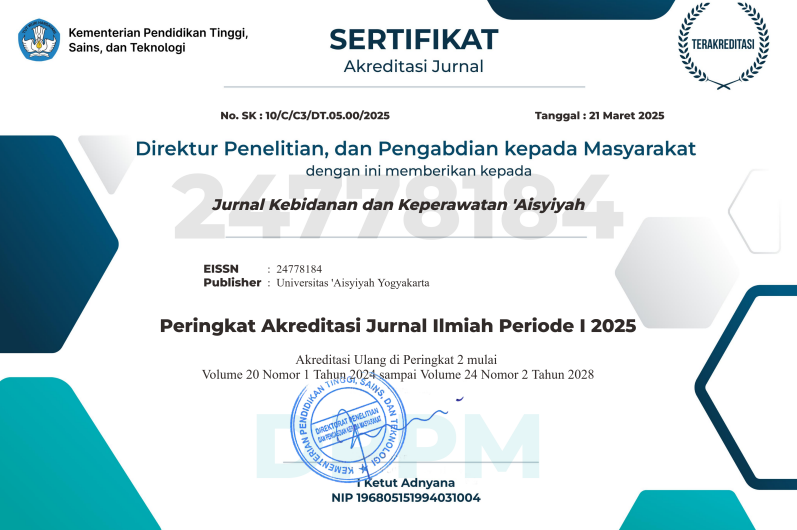The description of early initiation breastfeeding
DOI:
https://doi.org/10.31101/jkk.1163Abstract views 2045 times
Keywords:
early initiation breastfeeding, giving birth, health care providerAbstract
Downloads
References
Anne, R., Patrick, R., Elodie, P., & Philippe, R. (2018). Variation in Severe Postpartum Hemorrhage: A National Vignette-Based Study. Plos One.
Archana, P., Anita, B., & Amol, K. (2013). Factors Associated with Prelacteal Feeding and Timely Initiation of Breastfeeding in Hospital-Delivered Infants in India. Journal of Human Lactation.
Batt, S., Parikh, P., Kantharria, N., Dahal, A., & Parmar, R. (2012). Knowledge, Attitude and Practice of Postnatal Mothers for Early Initiation of Breastfeeding in the Obstetric Wards of A Tertiary Care Hospital of Vadodara City. National Journal of Community Medicine, 305-309.
Kemenkes. (2012). Peraturan Pemerintah (PP) No.33 Tahun 2012: Pemberian Aisr Susu Ibu Eksklusif. Diambil kembali dari Database Peraturan: https://peraturan.bpk.go.id/Home/Details/5245/pp-no-33-tahun-2012
Laili, R., Ermiati, E., & Mira, T. (2016). Process Evaluatin: Standard, Effectiveness, Efficiency and Sustainability of Maternity Nursing. Jurnal Keperawatan Padjajaran.
Muhammad, M. E., Hafiz, M. A., Zehra, N., & Haleema, H. (2013). Postpartum Hemorrhage: Causes and Management. BMC Research Notes.
PONEK, T. (2019). Panduan Rumah Sakit Sayang Ibu dan Bayi (RSSIB) RSUD Wates Tahun 2019. Yogyakarta: RSUD Wates.
Preddi, V., T, S., & D, M. (2015). Knowledge, Attitudes, and Breastfeeding Practices of Postnatal Mothers: A Cross Sectional Survey. International Journal of Health Sciences, 364-374.
Progo, D. K. (2018). Profil Kesehatan Tahun 2018 (Data 2017). Diambil kembali dari Dinas Kesehatan Kabupaten Kulon Progo: https://drive.google.com/file/d/17nK7jLrwcrfCk3mUujy9zgYPpYvUpkwz/view
Roesli, U. (2012). Inisiasi Menyusu Dini Plus ASI Eksklusif. Jakarta: Pustaka Bunda.
Victora, C. G., Bahl, R., Barros, A. J., Franca, G. V., Horton, S., Krasevec, J., . . . Rollins, N. C. (2016). Breastfeeding in the 21st Century: Epidemiology, Mechanisms, and Lifelong Effect. The Lancet, 475-490.
WHO. (2019). World Health Organization. Diambil kembali dari https://www.who.int/nutrition/bfhi/ten-steps/en/
Downloads
Published
How to Cite
Issue
Section
License
With the receipt of the article by the Jurnal Kebidanan dan Keperawatan Aisyiyah Editorial Board and the decision to be published, then the copyright regarding the article will be diverted to Jurnal Kebidanan dan Keperawatan Aisyiyah. Universitas 'Aisyiyah Yogyakarta as the publisher of Jurnal Kebidanan dan Keperawatan Aisyiyah hold the copyright regarding all the published articles in this journal.
Jurnal Kebidanan dan Keperawatan Aisyiyah is licensed under a Creative Commons Attribution-ShareAlike 4.0 International License.
















